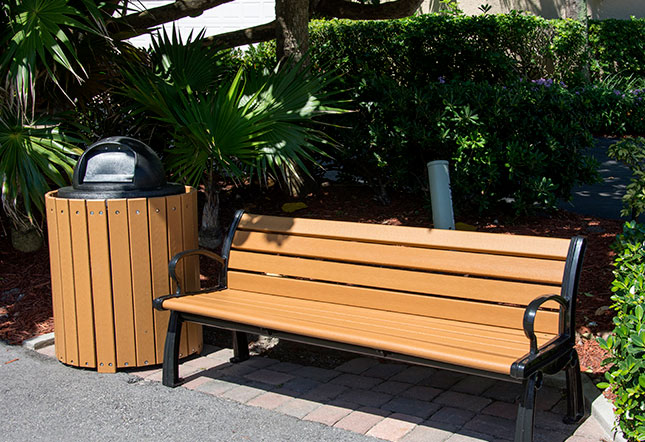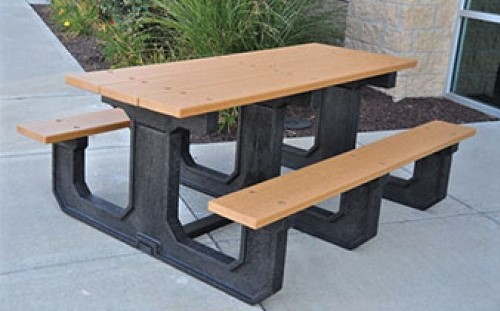When a 23-old student named Gary Anderson submitted his entry into a logo contest for Earth Day back in 1970, little did he know the impact his design would have on everything from recycling bins to recycled plastic benches.
The contest to adopt a "Universal Recycling Symbol" was the brainchild of the Container Corporation of America in Chicago, a recycled cardboard company, to help raise awareness about environmental issues.
At that time, Anderson was a student at the University of Southern California. Using inspiration from M.C. Escher (the artist who created those drawings of warped steps that seemed to defy gravity) and other influences, the young man submitted a drawing depicting three arrows moving in a circular direction. However, it's not a normal circle, but a "Mobius" configuration, where the arrows are twisted.
Anderson's entry won and he took home $2,500. But little did he know at that time his symbol would become one of the most recognizable images in the world. Over the years, the drawing Anderson created has become universally accepted as THE icon that best depicts and promotes the recycling process. In fact, it became so popular that the image is now considered to be in the public domain and anyone can use it.
The three arrows in his drawing are meant to represent the three stages of recycling. Most people are familiar with the first phase - Collection. That's the gathering of all those plastic bottles and newspapers they drop into recycling bins every week. Studies show about 80% of Americans now have access to curbside recycling, which is an impressive ecological accomplishment.
But for the entire recycling process to truly work, there are two other critical phases. The second phase concerns Processing, where newspapers, plastic bottles and other recyclable materials are efficiently ground down into scrap that can be used to manufacture products again.
The third phase is the actual recycling phase, where those recycled products are Purchased and reintroduced back into the marketplace.
Each phase is critical. If we only collected recyclable material but never did anything with it, the process would be a lesson in futility.
If we ground the plastic into scrap, but stopped there, we would just have enormous stockpiles of plastic pellets stored in warehouses.
It's only when that scrap is made into a recycled plastic bench or recycled newspapers and sold that the "loop" is completed and the process has true economic value.
In fact, the more "green" products such as recycled plastic benches that are purchased and put to use, the more economies of scale kick in to encourage recycling.
Here's the opportunity. Americans today only recycle about 34% of the garbage they create.
Yet, in a study by the Environmental Protection Agency conducted in 2007, it was found that the recycling industry employs 757,000 people, generates $36.6 billon in wages and $6.7 billion in tax revenues. And that's from only one-third of the total waste generated. Think of the benefits if we reused 50% or 60% of the solid waste that is created. The impact would be enormous.
Every time we reuse another 1,000 tons of recyclables, there are 1.57 jobs created and $76,030 in wages paid to a family. Every pound of recycled plastic used in production reduces energy use by 84% compared to using virgin materials. On average it costs $30 per ton to recycle trash, $50 to send it to a landfill and $65 to $75 to incinerate it.
That means it is cost-effective to prevent items such as plastic bottles from filling up landfills and instead transforming them into reusable items such as polar fleece, recycled plastic benches, tote bags and numerous other products.
Anderson's recycle logo is just one image involved in the recycling process. There are others.
Plastic category symbols for everything from grocery bags to recycled plastic benches
When it comes to plastic, there are a series of triangular recycling codes that rate plastics and determine how the materials can be reused.
Here's a rundown:
# 1 PET - polyethylene terephthaltate - this is one of the most common plastics and the type used in water and soda bottles. However, due to leaching the product can only be used once and then must be ground back down into pellets. The scrap can be reused to make bottles again or manufactured into a polyester type fiber that can create carpets and fleece clothing.
#2 HDPE - high density polyethylene - this is a stiffer type of plastic used in milk jugs, detergent containers, oil bottles, toys and plastic bags. The HDPE classification is the PRIME category for recycling material because its hardy properties make it easy to manufacture other goods. In addition, the tougher HDPE plastic is very durable and will not deteriorate from sunlight or weather.
This is why this material is ideal for a number of popular products - recycled plastic benches, recycled plastic picnic tables, recycled plastic trash cans, bed liners for trucks, etc.
# 3 PVC (polyvinyl chloride) - this material is a softer more flexible plastic and is used for plastic food wrap, cooking oil bottles, children and pet toys, computer cables, plastic plumbing parts, etc. Generally, this type of plastic it is not suitable for the recycling process.
# 4 LDPE - low density polyethylene - this plastic is often used for dry cleaner bags, shrink wrap and plastic grocery bags. It is not as hard as HDPE plastic but it is now integrated into some plastic lumber, tiles or garbage can liners.
# 5 PP (polypropylene) - this material is durable and resists heat, moisture, grease and chemicals. Most people come across this type of plastic after they open a cereal box and tear open the plastic liner inside. It is generally recycled into stripping, battery cases, brooms and trays.
#6 PS (polystyrene) - nearly everyone comes in contact with this type of plastic as its lightweight and inexpensive qualities make it ideal for creating Styrofoam containers, egg cartons, plastic forks and knives, and packaging peanuts.
This plastic is not rated well as far as toxicity and generally not recycled, although as you can imagine, all those Styrofoam boxes and cups take up a massive amount of landfill space.
# 7 Other Plastics - this category is for other plastics that use a variety of polycarbonates, and related materials such as BPA (Bisphenol). Any product marked with this symbol is generally not for reuse.
As you can see, it is very important for consumers to know the distinction between the different types of plastic products that should be targeted for recycling and what is not eligible for remanufacturing.
The HDPE-type plastic is at the top of the pile when it comes to recycling popular products that are in demand. In fact, the technology used to create products such as recycled plastic benches has advanced tremendously in the past few years. The manufacturing techniques at this point can create products that rival wooden benches or metal benches. The plastic recycled lumber, for example, has been shown to be very durable and long-lasting. Consequently, there is a huge demand for HDPE scrap.
Recycled plastic benches made with 100% pure recycled scrap can withstand damaging UV rays, rain, snow and freezing weather. This product will have a much longer shelf life than a wooden bench for example, as wood fibers will eventually deteriorate over time due to prolonged exposure to sunlight, moisture, heat and cold.
 Recycled plastic benches and recycled plastic trash receptacles are examples of the end products of the circular loop represented in the recycling symbol
Recycled plastic benches and recycled plastic trash receptacles are examples of the end products of the circular loop represented in the recycling symbol
"Recycling plays an important role in sustainable materials management and we will continue to educate, motivate and activate people to better understand the 'how, what, where and why' of recycling today and in the future," said Jennifer Jehn, President and CEO of Keep America Beautiful. "We must all be unified in helping to encourage the American people to recycle more of the right things the right way, while working together to address the challenges to make recycling even more successful."
This is critical when you consider that every American generates about 4.4 pounds of trash per day. That added up to 254 million tons in 2013, according to Keep America Beautiful. About 87 million tons of that trash was recycled or composted. That's good news. The not-so-good news is that we still only recycle about one-third of the garbage that's created.
With the advancement of recycled plastic products and the demand for "green" items, there is a HUGE opportunity here.
Throughout time, everyone knows symbols have played an important role in society.
However, when it comes to protecting Planet Earth, the recycling and plastic symbols signify a crucial, measurable role in our ability to sustain our planet's resources. We can get better at recirculating raw materials inexpensively and consequently create less of an impact on our natural resources.
Pay attention to symbols and be sure to get involved in the circular message that Gary Anderson was trying to convey 47 years ago with his simple design.
Place products in those recycling containers and encourage remanufacturing by purchasing products such as recycled paper or recycled plastic benches, thereby completing the circle where we can reuse the gifts our planet gives us.
 Plastic picnic tables manufactured with recycled plastic
Plastic picnic tables manufactured with recycled plastic


